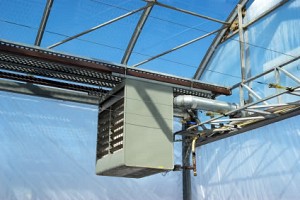Greenhouse Heating Options

There is an amazing array of options when considering how or if to heat your backyard greenhouse. This article explores the range of backyard greenhouse heating options and how to choose what is right for your budget and climate.
How Much Heat?
Depending on how frugal or creative you want to be, you can heat your greenhouse for 50 cents per square foot or up to $20+ per square foot. No matter where you live, there are cost-effective greenhouse heating options for you.
First, it’s helpful to know what zone you are in to assess how much effort you'll need to put into heating your greenhouse. The USDA’s Plant Hardiness Zone Map will help you determine your zone.
If you live in a temperate climate, you'll need to do little more than place your greenhouse properly to use the sun to your best advantage. The greenhouse should be positioned with its longest side facing south. If you have a glazed greenhouse, the roof should also be sloping to the south.
A relatively inexpensive type of greenhouse structure is known as the “hoop house.” Hoop houses are simple structures with plastic covers.You may have seen them while taking a drive in the country. In fact, if you see a hoop house that looks as though it’s not being used, you may be able to obtain it cheaply from the owner. One advantage of hoop houses is there are no standard dimensions, so nearly anyone can have one in his yard. They are passively ventilated with roll-up walls.
Easy Ways to Heat
No matter what type of greenhouse you have, you can go the easy way to heat it by using electric, gas or propane heaters. However, you would also need a source of electricity to run them. Electric heaters can cost from about $50 to $1,000, depending on the size of your greenhouse and the types of plants you are growing. Gas and propane greenhouse heating options run from $220 to as high as $2,000.
Daniel Bodkin of Laughing Dog Farm in Gill, MA, says, “If you are going to add propane, oil, wood, fans, or in-ground radiant heating, you’d best be sure the investment is worth it.” Bodkin adds that hoop houses are more minimally heated and “take maximum advantage of wind protection and thermal mass.”
Eco-Friendly Ways to Heat
If you are looking for more environmentally friendly greenhouse heating options, there are a number of novel ideas. Peter King, of Easthampton, MA, recommends waste biomass gasifiers. The gasifiers are efficient and clean and run on organic waste such as corncobs, twigs and yard debris. While they need electricity to run, you can purchase a gasifier for under $200 and add a solar charger for roughly $30 more.
Some gardeners heat their greenhouses with small wood or pellet stoves. If you have masonry skills, a masonry heater is labor and cost-intensive at first, but runs on little fuel and saves money over time, according to Tom Sullivan, Master Gardener, of Montague, MA. Masonry heaters produce radiant heat.
Dick Pierce of Austin, Texas suggests using compost piles to heat your greenhouse. Pierce, who runs permaculture workshops in Texas and on Martha’s Vineyard, says compost piles that are kept aerated are sweet-smelling and heat to 140-160 degrees. Pipes and hoses can be run from the compost pile to heat above and below ground. Pierce also notes one Martha’s Vineyard gardener who heats her greenhouse by way of the warmth naturally generated from her chicken coop.
Updated October 28, 2018.
Looking for a Pro? Call us (866) 441-6648

Landscaping Average Costs
Landscapers Experiences

Rock Landscaping Adds Curb Appeal To An Arizona Home

Leaf Removal This Year, More Landscape Work Next Summer



